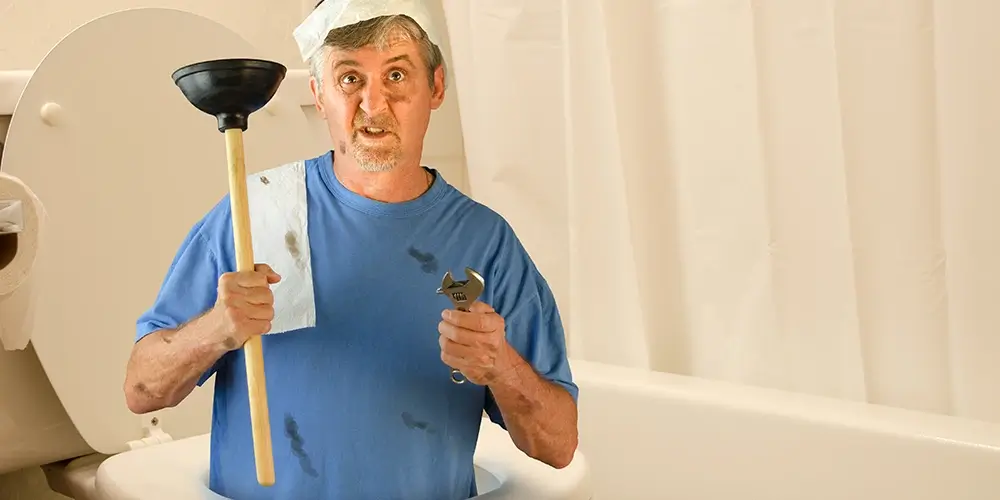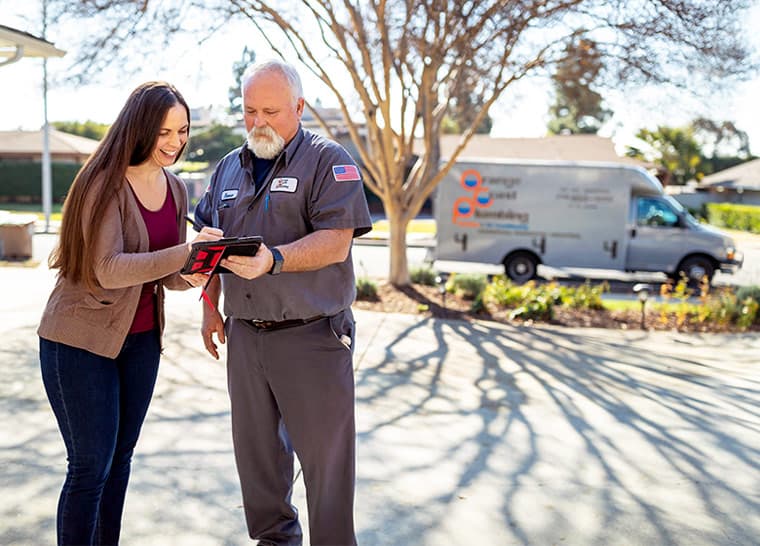Don’t try this at home!
Except that people have used these unusual techniques — and more — to fix a leaky toilet until they could call a plumber or run to the hardware store for a replacement part.
You can manage without a kitchen sink for a day — there’s always takeout — or a shower, but the toilet? It’s the one plumbing fixture you can’t do without, especially if there’s only one in the house or apartment. There are no alternatives short of porta-potty rental.
An old flapper that no longer seals, a broken or twisted flapper chain, or a malfunctioning float can cause untold misery for our good friend John, so here are just a few of the imaginative, funny, and sometimes crazy things people have done to keep him in the game.
1. Garbage bag twist ties to replace the toilet flapper chain
A twisted, too-short, or just plain botched chain between the toilet flapper and the float can be a plumbing headache. Such a simple thing! Yet, it may not allow the flapper to lower and seal the tank.
So if the chain is damaged beyond repair with no replacement part in sight, an easy temporary fix is to fashion a chain out of garbage bag twist ties (preferably the one with wires). It’s a DIY repair more durable and reliable than string, and who doesn’t have a few twist ties lying about?
Garbage tie chains are flexible, unlike heavier wire, and easy to adjust.
2. A styrofoam float support to stop the flow
A malfunctioning float can make a toilet leak. Floats measure how much water is in the tank and act as a shut-off valve once the tank is full.
If the float needs adjusting but won’t move, some DIY plumbing creatives report that placing a foam cup around the float arm helps push it up enough for the water to shut off. It’s obviously not a long-term solution, but it will keep a toilet in action until someone can repair or replace the float mechanism.
Some newer toilets have a float that moves on a vertical metal or plastic rod rather than on the arm. It can be challenging to adjust, and the toilet will keep running if it sits too high.A piece of styrofoam placed on the rod just below the lever pushes the lever up to stop the water flow.
3. Fixing the toilet flapper with Vaseline to seal against leaks
Your toilet’s flapper opens and closes. It opens to let water out and closes to seal the tank. It’s a thankless job, and the flapper does it without complaint until it suffers the pains of age. Sound familiar?
Flappers are made of flexible, rubberized material, which becomes brittle and cracks over the years. Cracks are the enemy of a tight seal.
Some cleaning products or toilet tank stick-on cleaners accelerate the process, sending the flapper to ruin that much sooner.
But there’s hope for our poor little flapper in the form of Vaseline, which can partially restore its youth and suppleness for a while.
- Drain the toilet tank.
- Dry off the toilet flapper. Rub Vaseline on the flapper and its connecting washer until they soften.
- Fill the toilet tank and check the seal.
You’ll have to retire the flapper at some point, but the Vaseline treatment may be enough to seal your toilet tank until you do.
4. The fish tank reservoir solution
One ingenious homeowner with a cracked toilet tank fashioned an alternate reservoir from an old fish tank filter system. He attached it to the overflow pipe on top of the toilet tank, then connected it to the toilet’s water supply line.
It worked like a charm until he got his replacement part — now that’s resourcefulness! Nothing fishy about it!
No matter the plumbing emergency, a creative solution may be waiting for you to try it. We hope these ideas put a smile on your face and help you find your unique fix for Sir John’s plight. Just remember to leave it to the pros for the tougher jobs! Good luck!
Orange Coast Plumbing is a family-owned, trusted company serving Orange County, CA. For service or information, please call us at 714-953-1111.
FAQs: DIY Toilet Repairs
Q: How can I fix a toilet that won’t stop running?
Often, a faulty flapper causes a continuously running toilet. To fix this, turn off the water supply to the toilet. Check the flapper (located at the bottom of the tank); if it’s warped or damaged, cover any gaps with a piece of plastic wrap until you can purchase a replacement.
Q: What should I do if my toilet doesn’t flush completely?
Adjusting the float ball can sometimes improve a partial flush. If it’s sitting too low, gently bend the arm holding the float ball upwards. This allows more water to fill the tank, creating a stronger flush.
Q: How can I unclog a toilet without a plunger?
Pour hot water and dish soap into the bowl. The soap can help lubricate the clog, while the hot water softens it. Wait a few minutes before trying to flush again. Alternatively, baking soda and vinegar can create a fizzing action that may dislodge the blockage.
Q: Is there a quick fix for a leaky seal at the toilet’s base?
Sealing a leaky base with silicone caulk is a temporary solution. Although this doesn’t fix the underlying problem, it can prevent water from leaking onto the floor until a proper repair (such as replacing the wax ring) can be done.
Q: How can I quiet a noisy fill valve?
Adjust the valve float. Lowering it can reduce pressure and noise. If this doesn’t work, wrapping the valve with a cloth or sponge can temporarily dampen the sound until you replace the valve.
Q: What should I do if my flapper closes too quickly?
Try attaching a small weight to the flapper chain. Household items like a small plastic bottle filled with water can serve as an effective weight to slow down the flapper’s closure rate, ensuring a complete flush.
Q: How can I prevent my toilet from “sweating” in humid weather?
Wrapping the toilet tank with an absorbent towel can help manage condensation by absorbing the moisture. For a more permanent solution, consider installing an anti-condensation tank liner, available at hardware stores.
Q: Can I use anything household to replace a broken tank lever temporarily?
You can use a sturdy string or wire in a pinch. Attach one end to the flapper and the other to the outside lever hole, allowing you to pull on the string as a temporary flush mechanism.
Q: How do you deal with a fill valve that won’t shut off?
First, check if the float is obstructed and remove any obstruction. If the valve still doesn’t shut off, try gently bending the float arm down to decrease the water level at which the valve shuts off. If these steps don’t work, the valve may need replacing.
Q: What’s a quick fix for a loose toilet seat?
If the screws are intact, wrapping the screws with plumbers’ tape can make them fit more snugly. Also, a small amount of epoxy applied to the screw threads can stabilize the seat temporarily.
Q: How can I make my toilet flush stronger?
Increasing the water level in the tank can strengthen the flush. Adjust the float valve to allow more water into the tank, ensuring it isn’t overfilled beyond its overflow tube.
Q: How do I stop my toilet tank from filling slowly?
Check the water supply line for kinks or blockages. If the line is clear, try partially closing and reopening the water supply valve to dislodge any debris inside the valve. If this doesn’t work, the issue might be with the fill valve, which may need cleaning or replacing.


